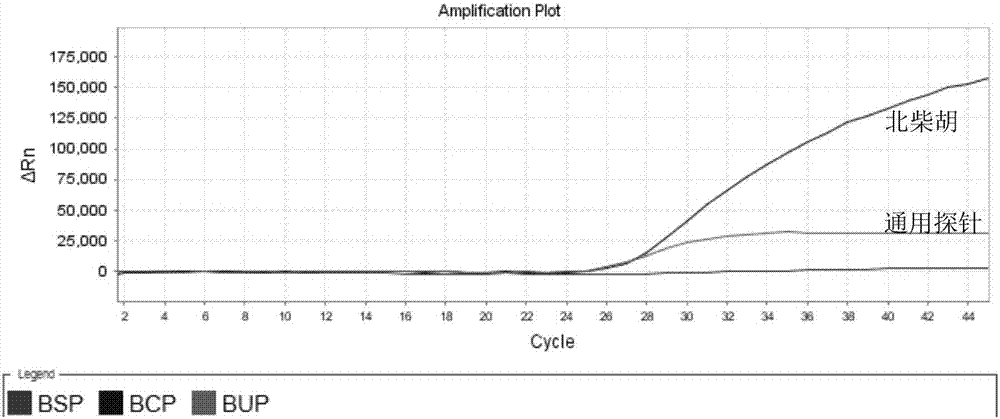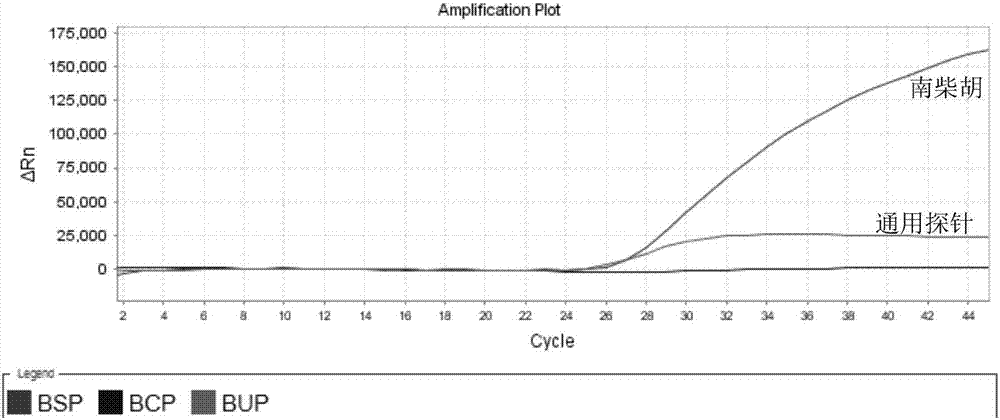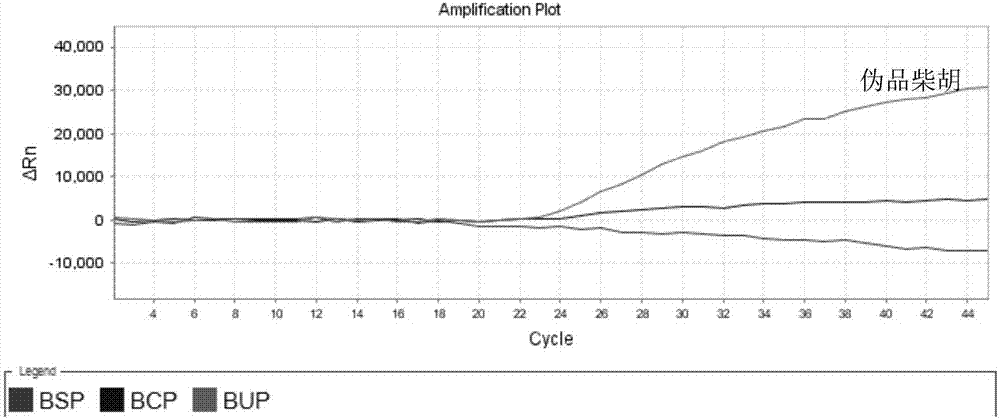Fluorescent PCR detection primer set, probe composition, kit, detection method for simultaneous identification of bupleurum scorzonerifolium and bupleurum chinense and application
A detection kit and detection primer technology, applied in the field of molecular biology detection and detection, can solve the problems of large limitations, high cost of supporting instruments, complicated identification operations, etc., and achieve significant differences between species, high accuracy and specificity. strong effect
- Summary
- Abstract
- Description
- Claims
- Application Information
AI Technical Summary
Problems solved by technology
Method used
Image
Examples
Embodiment 1
[0058] 1. DNA extraction of Bupleurum and counterfeit samples:
[0059] The plant DNA extraction kit was used for extraction, and the specific operation steps were found in the kit instruction manual. The purity and concentration of the extracted genomic DNA were determined by UV spectrophotometer. The measured OD260 / OD280 values are all around 1.8-1.9, and the concentration is above 10ng / μL, indicating that the DNA is of high purity and moderate concentration, which meets the requirements of PCR amplification.
[0060] 2. Selection of target genes and design of primers:
[0061] The ITS2 sequence is a non-coding sequence between the 5.8S and 28S rRNA genes. Because of its special structure and function in the overall ribosomal rDNA, it is both conservative and highly variable. There may be large differences among different species or individuals of the same species. Therefore, using the ITS2 sequence as the identification target gene of Bei Bupleurum has the characteristi...
Embodiment 2
[0071] Example 2 specificity verification
[0072] Utilizing the primers and probes designed by the present invention, Bupleurum bupleurum, Bupleurum chinensis, Bupleurum chinensis Yinzhou, Bupleurum xiaoyehei, Bupleurum coniferae, Bupleurum bamboo leaves, Bupleurum membranaceus, Bupleurum bupleurum, Narrow The total genomic DNA of plants such as Bupleurum bupleurum, Atractylodes macrocephala, ginseng, Codonopsis pilosula, habitat, dendrobium, yam, Millae vine, Chuanbei, and wolfberry were used as templates for real-time fluorescent PCR detection to verify the specificity of their primers and probes. The results are shown in Table 4 and Figure 4 with Figure 5 , the results show that the probes and primers designed in this study have strong specificity.
[0073] Table 4. Specificity Verification Tests
[0074]
[0075]
Embodiment 3
[0076] Embodiment 3 Sensitivity experiment
[0077] Quantify the genomic DNA of South and North Bupleurum to 50ng, dilute it in a 5× gradient, and take 2.0 μL for each gradient as the template amount (ie: 10ng, 2ng, 0.4ng, 0.08ng, 0.016ng) for real-time fluorescence quantification PCR detection to assess the detection limit of the present invention. See Image 6 with Figure 7 The result shows that the detection limit of the method is 0.08ng, which shows that the method provided by the invention has high sensitivity.
PUM
 Login to View More
Login to View More Abstract
Description
Claims
Application Information
 Login to View More
Login to View More - R&D Engineer
- R&D Manager
- IP Professional
- Industry Leading Data Capabilities
- Powerful AI technology
- Patent DNA Extraction
Browse by: Latest US Patents, China's latest patents, Technical Efficacy Thesaurus, Application Domain, Technology Topic, Popular Technical Reports.
© 2024 PatSnap. All rights reserved.Legal|Privacy policy|Modern Slavery Act Transparency Statement|Sitemap|About US| Contact US: help@patsnap.com










